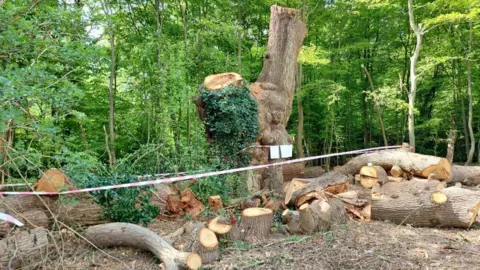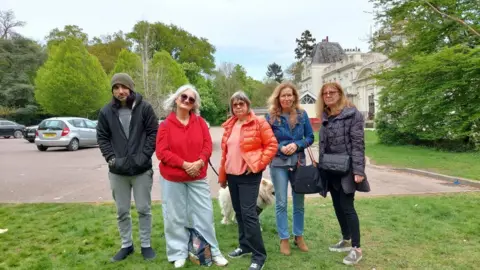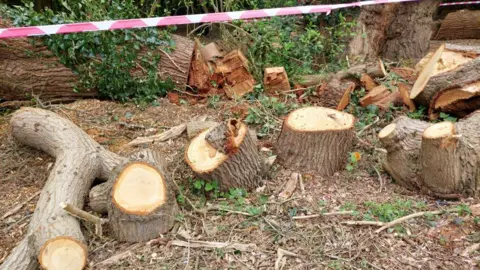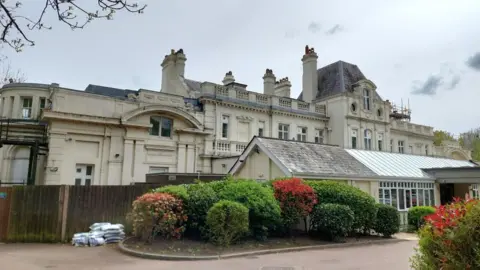 BBC
BBCWhether a tree falling in a forest makes a sound is a perennial subject of debate, but in one north London borough, it’s certainly made a lot of noise.
The felling of a 500-year-old oak tree earlier this month in Enfield has sparked outrage and a nationwide conversation.
First came the felling itself on 3 April which, it seems, few people noticed.
It wasn’t until 12 days later that the news emerged in a flurry of national headlines, after council workers found the slain tree in Whitewebbs Park.
Then came a plot twist that few would expect – the owners of Toby Carvery, a family pub chain specialising in budget roast dinners which has a restaurant overlooking the tree, admitted that they felled it after receiving advice it was dead.
The saga is a stark reminder of the emotional place that trees occupy in Britain’s national consciousness – coming not long after the iconic Sycamore Gap tree was felled at Hadrian’s Wall in Northumberland.
That’s evident in Enfield, where BBC News visited on Friday and found Amanda Dudley gazing at the remains of the oak, its former parts scattered around a blunted stump and cordoned off with red and white tape.
She lowered herself to sneak through and examine the tree’s 6m (20ft) wide trunk more thoroughly.
“I can’t believe they’ve done this,” she said. “This is a friend of mine.”
During lockdown Amanda, an artist, walked around Whitewebbs Park and says she looked at the tree every day. She has drawn sketches of it too.
“It was a real comfort to me,” she told me. “This is a place I’ve walked for years and years. I have quite a long relationship with this tree.”

Marina Cardozo, who walked around the area every day during lockdown, felt similarly. “It’s just so shocking, absolutely shocking,” she said. “500 years and they chop it down?”
While I was talking to her, other people were passing through the area to walk their dogs in the sun and take a look at what remained of the tree. One of them was Fatma Safer who told me she’s “heartbroken,” while her friend Felicity Pegg added: “Once it’s gone, it’s gone.”
A steady stream of gathered at the tree throughout the day, some taking selfies or pictures of their relatives standing in front of it.
A number of people who lived nearby told me that they couldn’t remember that particular tree, but that they were still saddened that a part of the park’s history had been destroyed.
Other people were less interested. Pippa Chapman’s young son had other thoughts, saying simply: “It’s been blown out of proportion.”

Unanswered questions
On Wednesday, Enfield Council’s leader branded the felling “an outrage” and said all legal options were being considered. It made a report of criminal damage to the police, but the Met is understood to view it as a civil matter.
In a letter seen by the BBC this week, Mitchells & Butlers (M&B), which owns the chain, apologised over the upset caused and admitted “we need to tighten our protocols”.
M&B said it felled the tree on health and safety grounds after receiving advice from unnamed contractors that “the split and dead wood posed a serious health and safety risk,” and stressed that “necessary measures to ensure any legal requirements were met”.
An Enfield Council planning document from March 2024 stated that the pedunculate oak – a species that can live for 1,000 years – was a “fine specimen” with high ecological and landscape value and had a life expectancy of at least five more decades.
While much has been said by both the council and M&B since the felling, locals and campaigners alike want answers to the many remaining questions.
Some people told the BBC that what surprised them most about the tree’s felling was how healthy it looked.
“It’s just so obviously not dead,” one resident claimed. “It’s a disgrace.”
“There’s nothing wrong with the tree,” Derek, another local, said. “I can’t see what problems it could have caused.”
They also question what the wood – currently still next to the remaining tree stump – will be used for.

Hope and potential change in future
Locals say the tree saga points to bigger picture of what they worry is happening to Whitewebbs Park, a place steeped in history – it’s home to Whitewebbs House which is where Guy Fawkes’s Gunpowder Plot is thought to have been hatched in 1605, and formerly owned by Henry VIII’s physician.
“There’s loads of controversy around here,” says a middle-aged couple that live nearby.
In February, Enfield Council gave Tottenham Hotspur football club a 25-year lease to build a new women’s training ground on the site of a former golf course in the park, with 11 pitches and a clubhouse, despite campaigners fighting against the proposals. Opponents argued that it would limit people’s access to green space and impact wildlife in the area.
The Woodland Trust has called for more transparency from M&B and the club. In the planning process to date, Spurs commissioned contractors to assess the woodland there.
There is no suggestion that Spurs knew of the decision to fell the tree or that it had any connection to it. A club spokesman told BBC News “the tree sits outside of our lease demise for our proposed Women’s and Girls’ Training Centre & Academy”.
Enfield Council and M&B did not respond to additional requests for comment.

In time, council officials may well get some answers on what went wrong for the Whitewebbs oak, and some locals are more hopeful.
A large portion of the tree’s trunk remains, and people visiting the site told the BBC they hoped it would start to regrow, even if it took decades, or centuries.
“I’m hoping I’ll come back here in a couple months and I’ll see some fresh shoots,” Zack Whitbread told me.
That’s what is starting to happen with the Sycamore Gap, with multiple shoots growing out of the stump which experts hope could develop significant growth to form new trees around the stump.
But perhaps the most impactful outcome of the felling in Enfield could be additional protections for Britain’s ancient trees.
An emergency tree preservation order has been imposed to preserve the remains of the Whitewebbs oak, given it is considered nationally significant.
The Woodland Trust is now among the campaigners who want legally protected status for heritage trees. As Adam Cormack, from the charity, put it: “This depressing sight is a reminder to all of us that not every ancient tree is in a safe place.”

